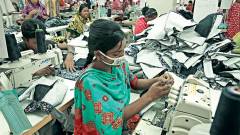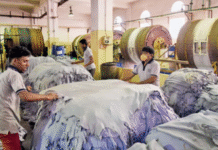Low cost labour, higher value-added textile sector keys to boost growth
Bangladesh’s share of global exports among 25 economies will increase to 3.8% by 2020 against the backdrop of low cost labour force, says a new report.
The 25 economies are Germany, Japan, France, UK, Australia, USA, Ireland, Poland, Singapore, Hong Kong, Canada, Argentina, Saudi Arabia, Korea, Mexico, UAE, Brazil, Bangladesh, Egypt, Indonesia, Malaysia, Turkey, India, China and Vietnam.
HSBC Trade Forecast, in its latest report released recently, said Bangladesh’s share of textile and garment exports will rise from 2.8% in 2010 to 3.8% in 2020 amongst the 25 economies.
Over 70% of survey respondents said the outlook for trade volumes will improve over the next six months, with almost 80% expecting the currency to have a favourable impact on business growth over this period.
It said low cost and a large number of young labour have encouraged the rapid growth of the textiles and garment sectors in Bangladesh, making it a leading supplier of ready-made garments to the West.
The strong foothold Bangladesh has in this market will underpin the growth in total merchandise exports over the coming decade, it said.
The ready-made garments make up around 80% of total merchandise exports from Bangladesh, with the value of exports in this sub-sector being greater than exports from India.
In 2013, half of Bangladesh’s exports of garments and textiles went to Europe and a quarter to the US.
The authorities have introduced new safety laws for textile factories to strengthen standards, which has helped reinforce established relationships with international buyers and in turn should help the industry to expand production, the report noted.
“The 77% increase in minimum wage for garment workers implemented in December 2013 will add to firm’s costs, but the industry is expected to remain competitive in global markets,” said the HSBC.
To improve longer-term growth prospects, Bangladesh will need to raise labour productivity and move into higher value-added textile sectors, it said.
Export values of ready-made garments rose by 13% in the first five months of 2014 after growing by 11.7% last year, according to the report. The US and the EU are the key export markets, taking almost two thirds of Bangladesh’s total exports last year and demand from these markets is on the upswing this year.
It said Bangladesh has a large young population and costs of production are lower than that in China. This presents opportunities for growth in low cost manufacturing sectors such as textiles and garments, which have been key drivers of growth in the economy.
The apparel industry alone employs around 4 million workers, with 70% being women. Bangladeshi exports rose by 11.9% in 2013 and have risen at a similar pace in the first five months of 2014.
New safety laws for textile factories introduced after a series of disasters could boost investors’ confidence. Meanwhile, the country has the fourth largest population in Asia and the working age population is growing. Investment should be increasingly aimed at services and consumer products to take advantage of this trend.
Amongst the 25 economies in the Trade Forecast, Bangladesh gets around 20% of its imports from China and by 2020 this share will have risen to closer to 30%. Other Emerging Market economies in Asia will also gain market share in Bangladesh at the expense of developed economies.
More than half of the Bangladesh’s population is employed in agriculture and animal products is the third biggest export sector, contributing almost 10% of export growth from 2014-16.
But the HSBC said as more of the population gradually moves towards urban areas, agriculture will decline in relative importance.
The country is seeking to boost its trade prospects further by freeing up trade with many of its neighbours, hoping to broaden its export base into higher value-added production and encourage FDI, the report said.
Source: Dhaka Tribune










